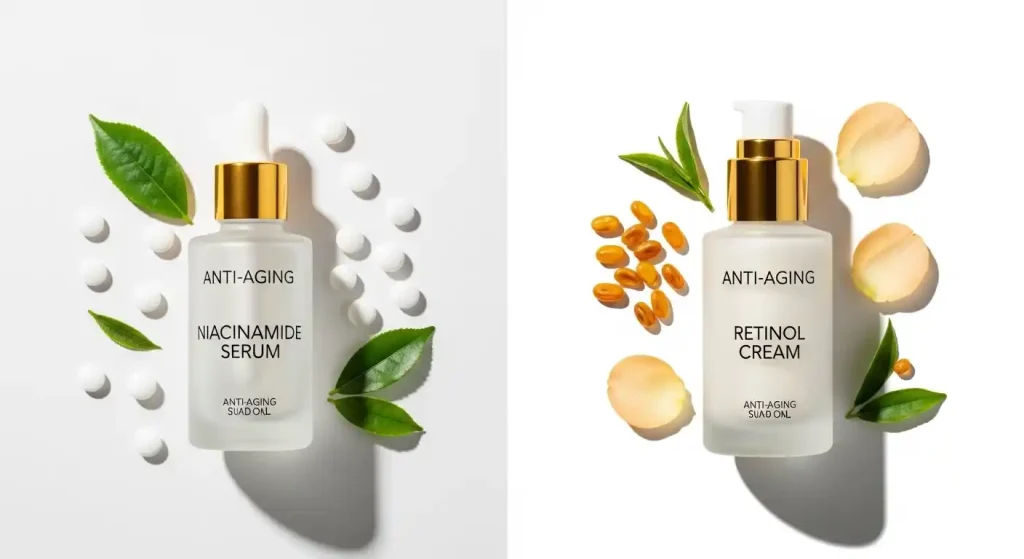In the world of anti-aging skincare, two powerhouse ingredients dominate the conversation: niacinamide and retinol. Both have earned their reputation as effective skincare ingredients for combating signs of aging, but they work in fundamentally different ways. If you’re wondering which one deserves a spot in your anti-aging routine, you’re not alone.
When used properly and consistently, retinol can reduce redness, inflammation and pore size, while simultaneously reducing the appearance of blemishes, hyperpigmentation and stubborn dark spots, making it a dermatologist favorite. Meanwhile, niacinamide reduces the appearance of fine lines by strengthening the skin barrier, improving elasticity, and reducing oxidative stress, offering a gentler approach to anti-aging skincare.
This comprehensive guide will explore the niacinamide vs retinol debate, helping you make an informed decision about which anti-aging ingredient is right for your skin type and concerns.
Understanding Anti-Aging Skincare Ingredients
Before diving into the niacinamide vs retinol comparison, it’s essential to understand how anti-aging skincare works. Aging skin exhibits several common concerns:
- Fine lines and wrinkles
- Loss of elasticity and firmness
- Uneven skin tone and texture
- Enlarged pores
- Dark spots and hyperpigmentation
- Reduced collagen production
Effective anti-aging ingredients target these concerns through various mechanisms, from stimulating cell turnover to strengthening the skin barrier. The choice between niacinamide and retinol often depends on your skin’s specific needs and tolerance levels.
Clean Beauty Products with Viral Appeal
Retinol: The Gold Standard of Anti-Aging Skincare
Retinol has long been considered the gold standard in anti-aging skincare. This vitamin A derivative works by accelerating cell turnover and stimulating collagen production, making it highly effective for addressing multiple signs of aging.
How Retinol Works for Anti-Aging
Retinol mainly penetrates the skin’s outer layer, where it converts to retinoic acid and begins its transformative work. The retinol benefits for anti-aging include:
Cellular Renewal: Retinol promotes faster skin cell turnover, revealing fresher, younger-looking skin beneath Collagen Stimulation: It encourages the production of new collagen, improving skin firmness and elasticity
Pore Refinement: Regular use helps minimize the appearance of enlarged pores Texture Improvement: Smooths rough skin and reduces the appearance of fine lines
Key Retinol Benefits for Mature Skin
1. Proven Anti-Aging Efficacy Research consistently shows that retinol is one of the most effective anti-aging ingredients available over-the-counter. It addresses multiple signs of aging simultaneously, making it a comprehensive solution for mature skin.
2. Wrinkle Reduction Studies demonstrate significant improvement in fine lines and wrinkles with consistent retinol use. The ingredient works both on surface-level concerns and deeper structural changes in the skin.
3. Hyperpigmentation Treatment
Retinol helps fade dark spots and even out skin tone by accelerating the shedding of pigmented cells and promoting the growth of new, evenly toned skin.
4. Acne Prevention Beyond anti-aging benefits, retinol also helps prevent breakouts by keeping pores clear and reducing inflammation.
Retinol Drawbacks and Considerations
While retinol benefits are impressive, this anti-aging ingredient does come with potential side effects:
- Initial irritation, dryness, and peeling
- Increased sun sensitivity
- Not recommended during pregnancy or breastfeeding
- Requires gradual introduction to the skincare routine
- Can be too harsh for sensitive skin types
Sustainable Fashion Brands to Watch
Niacinamide: The Gentle Anti-Aging Alternative
Niacinamide, also known as vitamin B3, has emerged as a powerful yet gentle anti-aging ingredient. Niacinamide penetrates deeper than retinol and works by helping to rebuild new skin cells and keratin, enhancing the skin’s natural lipid barrier, making it suitable for all skin types.
How Niacinamide Supports Anti-Aging
Unlike retinol, which works primarily through accelerated cell turnover, niacinamide focuses on strengthening and protecting the skin. The niacinamide benefits for anti-aging include:
Barrier Strengthening: Improves the skin’s protective barrier, reducing water loss and environmental damage Inflammation Reduction: Calms irritation and redness while promoting healing Pore Minimization: Helps reduce the appearance of enlarged pores Oil Regulation: Balances sebum production for healthier-looking skin
Key Niacinamide Benefits for All Ages
1. Universal Tolerance One of the biggest advantages of niacinamide is its gentle nature. The adverse side effects of retinol are not present in niacinamide, making it suitable for sensitive skin, pregnant women, and those new to anti-aging skincare.
2. Barrier Protection Better lipid barrier strength, increased keratin production, and improved skin moisture retention are all made possible thanks to niacinamide, creating a foundation for healthy, resilient skin.
3. Multi-Functional Benefits Niacinamide addresses various skin concerns simultaneously, including enlarged pores, uneven texture, dullness, and fine lines, making it an excellent all-around skincare ingredient.
4. Antioxidant Protection This anti-aging ingredient also functions as an antioxidant, protecting the skin from environmental stressors that accelerate aging.
Best Bakuchiol Serum 2025 – Gentle Retinol Alternative for Clear Skin
Niacinamide vs Retinol: Direct Comparison
Effectiveness for Anti-Aging
Winner: Depends on Concerns
Retinol is usually more effective than niacinamide for dramatic anti-aging results, particularly for deep wrinkles and significant sun damage. However, niacinamide excels at prevention and gentle improvement, making it ideal for early intervention and maintenance.
| Aspect | Retinol | Niacinamide |
|---|---|---|
| Wrinkle Reduction | High effectiveness | Moderate effectiveness |
| Skin Tolerance | Can cause irritation | Gentle for all skin types |
| Texture Improvement | Dramatic results | Gradual improvement |
| Pore Minimization | Good | Excellent |
| Barrier Support | Can weaken initially | Strengthens immediately |
Best Candidates for Each Ingredient
Choose Retinol If You:
- Have moderate to severe signs of aging
- Can tolerate potential irritation
- Are not pregnant or breastfeeding
- Want dramatic, visible results
- Have previously used anti-aging ingredients successfully
Choose Niacinamide If You:
- Have sensitive or reactive skin
- Are new to anti-aging skincare
- Want gentle, preventative care
- Are pregnant or breastfeeding
- Prefer a multi-functional skincare ingredient
Smart Air Fryer with App Control – Top Trending Kitchen Gadget 2025
Combining Niacinamide and Retinol for Maximum Benefits
The niacinamide vs retinol debate doesn’t have to be an either-or situation. Niacinamide and retinol can be combined in one product but are also available separately. They’re safe to use together and have several benefits when combined.
Strategic Layering for Anti-Aging Success
Morning Routine:
- Gentle cleanser
- Niacinamide serum (soothes and protects)
- Moisturizer with SPF
- Sunscreen (if not included in moisturizer)
Evening Routine:
- Double cleanse
- Wait 30 minutes after cleansing
- Retinol serum or cream
- Niacinamide moisturizer (optional, for extra barrier support)
Benefits of Combination Therapy
Enhanced Tolerance: Apply niacinamide first, let it absorb, and then apply retinol to reduce potential irritation from retinol while maximizing anti-aging benefits.
Comprehensive Results: This approach addresses multiple aspects of aging – retinol handles cellular renewal and collagen production while niacinamide strengthens and protects.
Improved Compliance: The gentling effect of niacinamide allows for better tolerance of retinol, leading to more consistent use and better long-term results.
Recovery Gear: Massage Guns vs Foam Rollers for Peak Performance
Building Your Anti-Aging Skincare Routine
Beginner-Friendly Anti-Aging Approach
Week 1-2: Foundation Building
- Morning: Gentle cleanser + Niacinamide serum + Moisturizer + SPF
- Evening: Cleanser + Moisturizer
Week 3-4: Gentle Introduction
- Add low-concentration retinol (0.25-0.5%) twice weekly in the evening
- Continue niacinamide daily in the morning
Month 2 and Beyond: Optimization
- Gradually increase retinol frequency as tolerance builds
- Maintain daily niacinamide for barrier support and gentling effects
Advanced Anti-Aging Protocol
For experienced users seeking maximum anti-aging benefits:
Daily Essentials:
- AM: Vitamin C + Niacinamide + SPF
- PM: Retinol (alternating with other actives)
Weekly Additions:
- Exfoliating acids (AHA/BHA) 1-2x weekly
- Hydrating masks for barrier repair
- Professional treatments as needed
HIIT vs Functional Training: Which Burns Fat Faster?
Choosing the Right Products
Quality Indicators for Anti-Aging Ingredients
When selecting niacinamide or retinol products, look for:
For Niacinamide:
- Concentration: 5-10% for optimal anti-aging benefits
- pH-balanced formulations
- Complementary ingredients like hyaluronic acid or ceramides
- Dark, airless packaging for stability
For Retinol:
- Start with 0.25-0.5% concentration
- Stable, encapsulated formulations
- Light-protective packaging
- Gentle base formulations to minimize irritation
Budget-Conscious Anti-Aging Options
Drugstore Winners:
- The Ordinary Niacinamide 10% + Zinc 1%
- CeraVe Resurfacing Retinol Serum
- No7 Protect & Perfect Intense Advanced Serum
Mid-Range Favorites:
- Paula’s Choice Clinical Niacinamide 20% Treatment
- Neutrogena Rapid Wrinkle Repair Retinol Pro+
- Olay Regenerist Micro-Sculpting Serum
Setting Up an Effective Home Gym: Complete 2025 Guide
FAQ Section
Can I use niacinamide and retinol together in my anti-aging routine?
Yes, niacinamide and retinol work exceptionally well together for anti-aging skincare. Use niacinamide in the morning to soothe and strengthen your skin and use retinol at night to promote cell turnover and reduce signs of ageing. This combination maximizes anti-aging benefits while minimizing potential irritation from retinol. You can also layer them in the evening by applying niacinamide first, followed by retinol after it absorbs.
Which is better for beginners: niacinamide or retinol for anti-aging?
Niacinamide is typically better for beginners starting their anti-aging skincare journey. Unlike retinol, which can cause initial irritation, niacinamide is gentle and suitable for all skin types, including sensitive skin. It provides immediate barrier-strengthening benefits and can be used daily without a gradual introduction period. Once your skin is comfortable with niacinamide, you can gradually introduce retinol for enhanced anti-aging benefits.
How long does it take to see anti-aging results from niacinamide vs retinol?
Retinol typically shows more dramatic anti-aging results faster, with improvements in skin texture visible within 4-6 weeks and significant wrinkle reduction after 12 weeks of consistent use. Niacinamide provides more subtle improvements, with pore refinement and skin barrier strengthening noticeable within 2-4 weeks. For optimal anti-aging benefits, both ingredients work best with consistent, long-term use as part of a comprehensive skincare routine.
Are there any side effects when using niacinamide or retinol for anti-aging?
Retinol can initially cause dryness, peeling, redness, and increased sun sensitivity – known as “retinol uglies.” These effects typically subside as skin builds tolerance. Niacinamide is generally well-tolerated with minimal side effects, though some people may experience mild irritation at very high concentrations (above 10%). Both anti-aging ingredients are safe for long-term use when introduced properly and used as directed.
Which anti-aging ingredient is better for sensitive skin: niacinamide or retinol?
Niacinamide is significantly better for sensitive skin in anti-aging skincare. It strengthens the skin barrier, reduces inflammation, and provides gentle anti-aging benefits without irritation. Retinol can be too harsh for sensitive skin types, potentially causing redness, peeling, and increased sensitivity. If you have sensitive skin but want to use retinol, start with the lowest concentration possible and consider using niacinamide alongside it to buffer potential irritation.
Complete Guide to Holistic Self-Care Practices
The Verdict: Niacinamide vs Retinol for Anti-Aging
Both niacinamide and retinol deserve recognition as powerhouse anti-aging ingredients, but they serve different roles in an optimal skincare routine. Retinol delivers more dramatic results for established signs of aging, while niacinamide provides gentle, preventative care with excellent tolerance.
The most effective approach often involves using both anti-aging ingredients strategically – niacinamide for daily barrier support and gentle improvement, and retinol for targeted cellular renewal and collagen stimulation.
Remember that consistency trumps intensity in anti-aging skincare. Whether you choose niacinamide, retinol, or both, the key is finding a routine you can maintain long-term. Start slowly, listen to your skin, and adjust your approach based on your results and tolerance.
Your anti-aging journey is unique, and the best skincare ingredient is the one that works consistently for your specific skin type and concerns.
Ready to transform your skin with proven anti-aging ingredients?
Start your journey to younger-looking skin with our curated selection of dermatologist-recommended niacinamide and retinol products. Get 20% off your first anti-aging skincare order and free consultation with our skincare experts.
Niacinamide serums (e.g. The Ordinary Niacinamide 10% + Zinc) :
retinol alternatives (bakuchiol creams) :
– Your best skin starts today.











